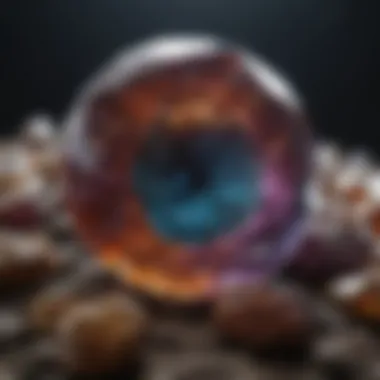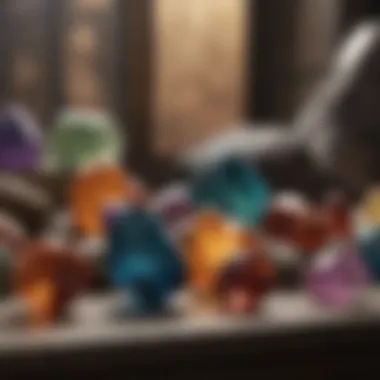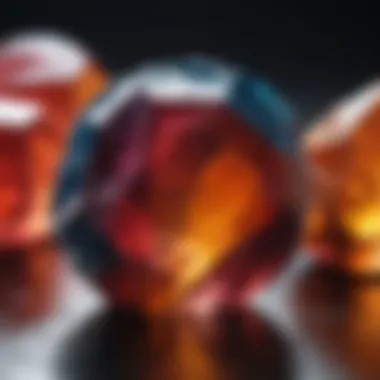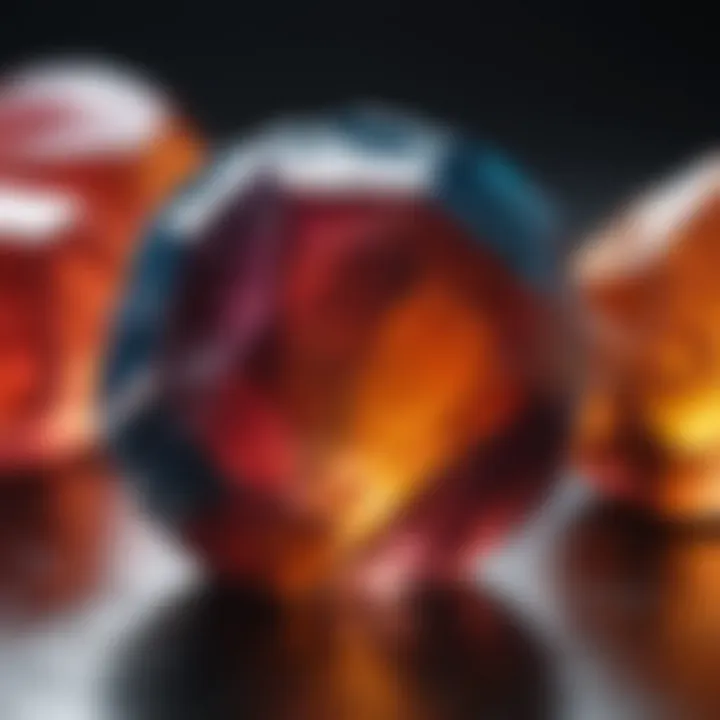Large Gemstones: Care, Value, and Display Techniques


Intro
Large gemstones hold a significant place in the world of collectibles. Their sheer size and beauty capture the attention of many enthusiasts. These gemstones are not merely decorative items but also carry historical and cultural weight. Understanding their origins, classifications, and care is essential for anyone looking to include them in their collection.
History and Origins
Overview of Collectibles, Rocks, and Fossils
The fascination with large gemstones can be traced back to ancient civilizations that valued them for their beauty and rarity. Collecting rocks and fossils is not a new phenomenon; it has roots in human history. Early humans used gemstones for various purposes, from crafts to trade. Collectors often begin with small, unique pieces and, over time, progress to larger, more impressive items.
Historical Significance and Cultural Impact
Many cultures have regarded large gemstones as symbols of power and wealth. For instance, the British Crown Jewels consist of numerous gemstones, each with its own story. These stones have been used in ceremonial occasions and symbolize royalty. In various traditions, gemstones are believed to possess mystical properties, influencing health and fortune.
"The allure of gemstones spans centuries, intertwining beauty with history."
Identification and Classification
Guide to Identifying Rocks and Fossils
Identifying large gemstones can be a rewarding experience. Each stone has specific characteristics: color, clarity, cut, and carat weight. This makes it easier to determine authenticity and value. Knowledge of gemology can significantly enhance a collector’s ability to make informed decisions.
Common Types and Variations
Collectors should be familiar with a range of large gemstones. Popular types include:
- Amethyst: Known for its striking purple hue.
- Topaz: Available in various colors, this gemstone is often used in jewelry.
- Emerald: Valued for its vibrant green shade, it has historical significance.
Understanding the differences between these stones and their variations can deepen appreciation and enhance curatorial decisions.
Understanding Large Gemstones
Large gemstones hold a unique position in the world of collectibles. Their allure is not solely based on beauty; they embody historical, cultural, and scientific significance as well. To truly appreciate these extraordinary natural wonders, one must delve into their definitions and characteristics, as well as their historical significance. This understanding paves the way for informed collecting, display, and caring practices.
Definition and Characteristics
A large gemstone is generally defined as a piece of mineral that has been cut and polished to show its brilliance and color. Typically, these stones weigh more than five carats. The characteristics that define them include clarity, color, cut, and carat weight. Clarity refers to the presence of inclusions or flaws in the stone. Color, which is essential to the overall appeal, varies and can signify quality and rarity. Cut is perhaps the most crucial attribute, determining how light interacts with the stone. Finally, carat weight directly affects the stone’s value.
The combination of these characteristics dictates not only the visual appeal but also the market demand and investment potential of large gemstones.
Understanding these aspects helps collectors in making educated decisions when purchasing gemstones. For instance, a well-cut, low-color but highly clear stone can sometimes outshine a vibrant, flawed counterpart. This knowledge is critical for guiding collectors as they expand their valuable collections.
Historical Significance
The historical context of large gemstones is rich and varied, often representing wealth, power, and prestige across cultures. Throughout history, gems like the Koh-i-Noor, the Hope Diamond, and others have been central to royal artifacts and significant events. These stones were often viewed as symbols of divinity or protection.
Moreover, large gemstones have played pivotal roles in various societies. For example, the ancient Egyptians valued lapis lazuli, using it in burial masks and jewelry. In other cultures, gemstones were believed to possess healing properties. Knowing this historical backdrop enhances appreciation for each large gemstone, providing a narrative that connects the piece to its past owners and the civilization it originated from. This connection increases its allure and can significantly impact its value.
Types of Large Gemstones
Understanding the types of large gemstones is crucial for both collectors and enthusiasts. This knowledge helps in identifying which gemstones best fit personal collections and displays. The distinction between precious and semi-precious stones is significant. It influences market value, aesthetics, and overall appeal.
Precious vs. Semi-Precious Stones
Precious gemstones, such as diamonds, sapphires, rubies, and emeralds, are often regarded as the most valuable. Their rarity and the demand contribute to their high prices. In contrast, semi-precious stones, including amethyst, citrine, and topaz, are more abundant but still hold beauty and unique characteristics. Each type offers distinct advantages:
- Investment: Collectors often prefer precious stones for their potential appreciation in value.
- Aesthetic Versatility: Both categories can enhance display settings, providing different visual impacts.
- Accessibility: Semi-precious stones tend to be more accessible for beginners and casual collectors.
Selecting between the two requires understanding personal goals in collecting and displaying gemstones.
Popular Large Gemstone Varieties
Several gemstones have gained popularity among collectors due to their beauty and characteristics. Each of these (Amethyst, Sapphire, Emerald, and Topaz) holds significance in the realm of large gemstones.


Amethyst
Amethyst is a popular choice for collectors. Its deep purple color is attractive and symbolizes luxury. It is often regarded as a stone of tranquility and clarity. Amethyst’s affordability makes it accessible for various display options. The clarity and uniformity of color can greatly enhance the visual appeal in collections. However, it’s important to note that its value can be impacted by the intensity of color.
Sapphire
Sapphire is renowned for its durability and range of colors. The classic deep blue sapphire is most popular, but it can be found in various hues. This gemstone symbolizes wisdom and nobility, increasing its appeal to collectors. Its exceptional hardness makes it durable for display, but its market value can demand a higher investment.
Emerald
Emerald is distinguished by its vibrant green color. Known for its rarity, it often captures the attention of high-end collectors. The unique way emeralds can display inclusions gives them character; some view these as enhancements rather than flaws. However, this feature can also lead to misunderstandings regarding quality. Collectors must be aware that without suitable care, emeralds can be more susceptible to damage.
Topaz
Topaz is loved for its many color variations, including blue, yellow, and pink. This gemstone’s clarity and brilliance can delight any collector. Topaz is relatively durable, but it is essential to understand its sensitivity to certain cleaning methods. This adds an extra layer of care required for maintaining its luster. Though often less expensive than other large gemstones, its unique qualities make it a worthwhile addition to any collection.
Large gemstones like Amethyst, Sapphire, Emerald, and Topaz are not just about aesthetics. They hold cultural significance and can serve as excellent conversation starters. This understanding enhances the appreciation of gems displayed in collections.
Evaluating Gemstone Quality
Understanding the quality of large gemstones is crucial for anyone involved in collecting or displaying these natural wonders. When we speak of gemstone quality, we refer to several key factors that can significantly impact the stone's aesthetic appeal and monetary value. Evaluating gemstones through these lenses ensures that collectors make informed decisions. This segment will explore cut and clarity, color, and carat weight, all of which form the foundation of assessing a gemstone's overall quality.
Cut and Clarity
The cut of a gemstone plays a pivotal role in its visual appeal. It can enhance brilliance and how light interacts with the stone. The precision of a cut reflects in the stone's ability to refract light, thus affecting the sparkle and scintillation. For large gemstones, such as the exquisite Emerald or vibrant Sapphire, a well-executed cut is integral to bring out their unique properties.
Clarity is another important characteristic that must be assessed. This refers to the presence of internal flaws or external blemishes. A stone with high clarity will appear clear and radiant, adding to its overall value. Depending on the type of stone, minor inclusions may be acceptable, but generally, the fewer the visible imperfections, the higher the quality of the gemstone. Evaluating both cut and clarity can provide collectors with a better understanding of what they possess and how it may be valued in the market.
Color and Carat Weight
Color is perhaps the most immediately recognizable factor in determining a gemstone's quality. For example, the depth of blue in a Sapphire or the lush green of an Emerald can define its allure. Gemstones vary widely in hue, tone, and saturation. Collectors should look for those that exhibit vivid, saturated colors as these are often most sought after. However, color preferences can also be subjective, heavily influenced by trends or individual tastes.
Carat weight adds another layer to the assessment. Generally, larger gemstones are rarer and thus can command higher prices. Carat weight measures the mass of the gemstone. A significant carat weight contributes to the perception of value, but it must be balanced with the quality of cut and clarity. Collectors should consider that two stones of the same carat weight can have vastly different values based on these other factors.
"A comprehensive evaluation of gemstone quality provides buyers and collectors with essential insights into their investments, guiding them toward informed decisions about purchases and displays."
When assessing quality, it is essential to consider these aspects holistically. A balance of cut, clarity, color, and carat weight will determine not only the visual impact of the stone but also its significance within a collection.
The Role of Gemstone Displays
In the realm of large gemstones, displays play a pivotal role. They are not merely vessels that hold these exquisite stones; they serve as the bridge between the gemstone and the observer. Displaying large gemstones effectively can amplify their allure and enhance the overall appreciation of these natural treasures. Considerations regarding layout, lighting, and context are paramount when choosing how to present a gemstone. The right display can transform mere collectables into focal points of admiration.
Aesthetic Appeal
The aesthetic aspect of gemstone displays is essential. A well-designed display can elevate the beauty of a gemstone, showcasing its color and clarity. For instance, when amethyst is illuminated appropriately, its rich purple hue can captivate any audience. Choosing the right design for the display is crucial. Options may include glass cases with built-in lighting or open arrangements that allow for close viewing. Decorative elements, such as stands made from wood or metal, can further enhance the appearance of the piece.
Lighting also plays a significant role. Natural light can bring out the best in gemstones, but controlled artificial light is often used to focus attention where it is needed. Taking care to avoid harsh reflections is vital, as they can detract from the overall effect.
Educational Value
Displays also serve an educational purpose. They provide context and background to large gemstones. For instance, cases can feature informative labels that detail the stone’s origin, significance, and qualities. This can enhance the viewer's understanding and appreciation.
By integrating educational elements into the display, collectors can communicate the story behind each gemstone. For example, sharing the history of the Cullinan Diamond enriches the experience for the observer. Such narratives can turn a simple viewing into a learning opportunity, making the display more valuable.
In addition, displays can facilitate discussions between enthusiasts and newcomers alike. Creating a space where people can engage and share information about gemstones can foster a sense of community and encourage exploration.
"Effective displays transform gemstones from mere objects into intricate narratives that captivate and educate all who view them."
In summary, the role of gemstone displays should not be underestimated. They encompass aesthetic and educational elements that enrich the experience of both collectors and casual observers. Whether through thoughtful design or informative presentation, displays breathe life and meaning into large gemstones.
Methods of Displaying Large Gemstones
Displaying large gemstones effectively is crucial for enhancing their beauty and significance. The way a gemstone is presented can greatly influence its appeal, whether for personal enjoyment or as part of a broader collection. Proper display methods not only protect the gemstones but also engage viewers, sparking curiosity and admiration. For collectors and enthusiasts alike, understanding these methods is essential for maximizing the impact of these stunning pieces.


Display Cases
Display cases serve as the most common and protective environment for large gemstones. They can be found in museums, galleries, and private collections. A good display case should offer visibility and protection.
Importance of Display Cases
- Protection: They safeguard large gemstones from dust, moisture, and physical damage.
- Visibility: A well-designed case allows for unobstructed views of the gemstone from multiple angles.
- Lighting: Proper lighting inside a display case can enhance the color and brilliance of the stone.
- Information: Cases can provide additional details about the stone, such as its origin and characteristics.
When selecting a display case, consider the size and type of gemstone. Cases made from glass or acrylic often work best, as they provide clarity without distortion. Additionally, secure locks are important to prevent theft or accidental damage.
Sculptural Arrangements
Sculptural arrangements involve integrating large gemstones into artistic displays. This method highlights the gemstone while showcasing artistic intent. These arrangements can be striking and memorable.
Elements of Sculptural Arrangements
- Artistic Appeal: Arrangements capture the essence of the gemstone in a context that enhances its beauty.
- Customization: You can create personalized displays that reflect themes or stylistic preferences.
- Interaction: Such displays can encourage viewers to engage with the gemstone beyond just a visual inspection.
When planning a sculptural arrangement, consider the balance and harmony between the gemstone and accompanying elements. Pairing gemstones with materials like wood, metal, or stone can help create a cohesive look.
Natural Settings
Natural settings involve placing large gemstones in environments that mimic their geological formations or origins. This neutral backdrop emphasizes the stone’s natural beauty and origin.
Benefits of Natural Settings
- Authenticity: It creates a sense of realism, connecting the gemstone to its natural environment.
- Contrast: Natural settings can help highlight specific hues and features of the gemstone.
- Context: This method can educate viewers about where gemstones are found and how they form.
For effective natural settings, select a base that complements the gemstone’s colors while reflecting the geological context. Materials such as sand, gravel, or even rock slices can create an engaging presentation.
Using diverse display methods not only protects but also elevates the perception of large gemstones in a collection.
Caring for Large Gemstones
Caring for large gemstones is crucial for maintaining their beauty and value. As these stones are often significant investments, understanding how to care for them properly can greatly affect their longevity. Since they can be fragile or prone to damage, specific care routines are necessary to ensure they remain in pristine condition.
Proper maintenance not only enhances their aesthetic appeal but also preserves their market value. In the realm of collecting, it's essential to be knowledgeable about cleaning techniques and storage recommendations to protect these precious items.
Cleaning Techniques
Cleaning large gemstones requires a careful approach. Different gemstones have varying properties, which means some may be more sensitive to certain cleaning methods than others. Here are some effective techniques:
- Soapy Water: A mild dish soap solution is often safe for most gemstones. Use a soft cloth or a brush to gently scrub the surface.
- Ultrasonic Cleaners: These devices can be effective for cleaning, but caution is necessary. Some stones, like emeralds, may crack or become damaged due to vibrations. Always check if the stone is suitable for this method.
- Avoid Harsh Chemicals: Never use bleach or strong solvents, as they can harm the gemstone's surface and its inherent properties.
- Rinse Thoroughly: After cleaning, ensure that all soap residues are washed off to prevent cloudiness or residue buildup.
"Regular maintenance ensures that your large gemstones remain vibrant and captivating, ready to be displayed for years to come."
Storage Recommendations
Storing large gemstones properly is another vital aspect of care. Incorrect storage can lead to scratches, chips, or even breakage. Here’s how to store these valuables:
- Use Individual Pouches: Each gemstone should be stored in a soft cloth or suede pouch. This reduces the risk of scratches against other stones.
- Keep Away from Sunlight: Direct sunlight can fade the color of certain gemstones. Choose a dark or shaded area in your storage space.
- Avoid Extreme Temperatures: Large temperature fluctuations can warp stones over time. Keep them in a stable environment.
- Consider a Display Case: If not in a pouch, a display case with compartments can protect them from dust and potential damage. Make sure that the materials inside the case are gentle.
- Use Soft Materials for Dividers: If you use a box, line the compartments with soft materials to cushion the stones from impact.
Taking diligent care of large gemstones is essential for any collector. The combination of effective cleaning and proper storage will ensure these stunning pieces remain not only beautiful but also valuable assets for the long term.
Market Trends in Large Gemstones
The world of large gemstones is continuously evolving, influenced by various factors such as market demand, technological advancements, and changing consumer preferences. Understanding the market trends in large gemstones is critical for collectors, investors, and enthusiasts. It provides insights into the nuances of what drives the market and helps inform decisions regarding purchases and collections. As interest in the natural beauty of gemstones increases, recognizing these trends can greatly benefit those engaged in the field.
Current Demand Analysis
An essential factor in the market for large gemstones is the current demand. Over the years, the interest in unique and historic gemstones has grown significantly. This increase can be attributed to a few key elements:
- Celebrity Influence: The fascination with large gemstones is often propelled by celebrity endorsements and high-profile auctions. When a famous individual wears or showcases a large gemstone, it becomes desirable to the public.
- Collector Community Growth: Organizations and communities focused on gem and mineral collecting are expanding. The exchange of information among collectors generates enthusiasm and motivates new collectors to enter the market.
- Cultural Appreciation: Increasing awareness of the historical and cultural significance of gemstones drives interest. Items such as large sapphires or emeralds are seen not only as aesthetic objects but also as tangible links to history.


The confluence of these elements suggests a robust demand for large gemstones that appears unlikely to diminish in the near future.
Investment Potential
Beyond aesthetic appeal, large gemstones are increasingly viewed as a strategic investment. This perception stems from several insights:
- Value Appreciation: Historical data indicates that certain large gemstones appreciate significantly over time, often outperforming traditional investments like stocks or bonds. The rarity of specific stones makes them more valuable, especially as collectors seek these unique pieces.
- Portfolio Diversification: Investors look to diversify their portfolios, and large gemstones provide an alternative asset class. As an investment, they can offer protection against market volatility.
- Emergence of Technology: Advances in technology have also influenced the investment landscape. Tools such as blockchain technology allow for transparent tracking of gemstone provenance, enhancing buyer confidence in authenticity and value.
"Large gemstones are not only artifacts of beauty but can also serve as valuable assets in a diversified portfolio."
Understanding these dynamics ensures that stakeholders can navigate this intricate market effectively.
Case Studies of Notable Large Gemstones
Exploring case studies of famous large gemstones provides a rich context for understanding these impressive minerals. Each gemstone tells a story, revealing not only its unique characteristics but also its historical and cultural significance. These cases can help collectors discern the intrinsic value of gemstones, showcasing how rarity, provenance, and artistry can enhance desirability.
Studying notable gems like the Hope Diamond and the Cullinan Diamond allows enthusiasts to appreciate the craftsmanship and historical narratives that surround these stones. This exploration also informs best practices for collection and display, as understanding the origins and journeys of these stones might influence collectors to assess their own pieces through a deeper lens. Moreover, such case studies invite discussions about ethical considerations in gemstone acquisition and display.
The Hope Diamond
The Hope Diamond is perhaps one of the most famous gemstones in the world. With its deep blue color, this large cushion-cut diamond weighs approximately 45.52 carats. Its historical context adds tremendous value; it has passed through various owners, including royalty. Its rumored curse has further embedded it into popular culture.
Originally from India, the diamond was acquired in the 17th century by a French merchant, who later lost it to theft. After various transactions and ownerships, it found its way to the Smithsonian Institution, where it is on display today. The Hope Diamond's significance is not just in its beauty, but also in its tale of loss, recovery, and fascination.
The unique color of the Hope Diamond is due to the presence of boron, which is quite rare in gemstones. This characteristic sets it apart from others and contributes to its allure. Collectors often look for such distinguishing features in their gemstones, as they can elevate both market and aesthetic value.
The Cullinan Diamond
The Cullinan Diamond is one of the largest gem-quality diamonds ever discovered, weighing a staggering 3,106 carats. Found in South Africa in 1905, it was named after Sir Thomas Cullinan, the mine's owner. The diamond was mined and eventually presented to King Edward VII of the United Kingdom.
Due to its sheer size, the Cullinan was cut into several gemstones, the largest being the Cullinan I, or the Star of Africa, which is now enshrined in the British Crown Jewels. The Cullinan Diamonds are notable not just for their size but also for their impeccable quality. They possess an exceptional clarity and brilliance that embodies the ideal qualities sought after by collectors.
The history of the Cullinan Diamond is compelling as it reveals the imperial ambitions and jewel collection practices of the early 20th century. Its various cuts and the subsequent gemstones reflect both the artistry of the gem cutters and the desire for regal display.
Both the Hope and Cullinan Diamonds serve as reminders of the value placed on large gemstones, transcending mere physical beauty to encompass historical narratives and cultural significance.
The Future of Gemstone Collecting
The realm of gemstone collecting is poised for a transformation as trends evolve and technologies advance. As collectors, both new and seasoned, navigate this landscape, understanding the future is crucial. The importance of examining what lies ahead not only helps in identifying promising investments but also in enhancing the overall collecting experience.
Emerging Trends
In recent years, the market for large gemstones has shown intriguing trends that collectors should watch closely. Several factors contribute to these changes:
- Sustainability: Increasing awareness and concern for environmental impacts lead to a rising demand for ethically sourced gemstones. Collectors are prioritizing stones that come with certifications demonstrating environmentally responsible practices.
- Personalization: The customization of gemstone pieces is on the rise. Collectors seek unique designs that reflect personal narratives or aesthetics, moving away from mass-produced options. This trend aligns with a broader societal shift towards individualism.
- Community Engagement: Online platforms have facilitated stronger communities around gemstone collecting. Forums on Reddit and social media groups on Facebook allow collectors to share knowledge and trade specimens. The focus on community enhances the learning experience for both novice and expert collectors.
These trends indicate a shift in the collector's mindset, favoring a more discerning approach to purchasing and showcasing large gemstones.
Advances in Technology
As technology progresses, it significantly influences how gemstones are sourced, evaluated, and displayed. Several advancements are noteworthy:
- Lab-Grown Gemstones: Technological advancements have made it practical to create lab-grown alternatives that often exhibit similar characteristics to natural stones. This trend enables collectors to access beautiful, high-quality pieces at more affordable prices, while also considering ethical implications.
- 3D Gemstone Printing: The emergence of 3D printing technology revolutionizes the customization of gemstone jewelry. Collectors can now create one-of-a-kind pieces tailored to personal tastes, enhancing their collections without the limitations posed by traditional methods.
- Augmented Reality (AR): Innovations in AR allow collectors to visualize how gemstones will look in various settings or as part of jewelry designs. Users can use their smartphones to superimpose images of their collections in real-time environments, making display decisions easier and more informed.
These technological advances not only open new avenues for collectors but also reshape the market dynamics, making it an exciting time for enthusiasts.
The End
The conclusion of this article serves as a critical summation of the vital themes discussed regarding large gemstones for display. It ties together the various threads of information presented, highlighting their significance in the realms of both collecting and appreciation.
The importance of large gemstones cannot be overstated. These stunning natural marvels are not only visually appealing but also carry historical and cultural weight. Collectors and enthusiasts cherish them for their unique characteristics, rarity, and potential for investment. Understanding the nuances of evaluating quality, display methods, and care techniques becomes indispensable for anyone serious about the pursuit of gemstone collecting.
Summary of Key Points
- Large gemstones serve as more than mere decorations; they embody history, beauty, and investment potential.
- Evaluating factors like cut, clarity, color, and carat weight is essential for identifying quality stones.
- Effective display methods enhance both the aesthetic appeal and educational value of gemstones, making them meaningful artifacts in any setting.
- Care techniques and proper storage ensure the longevity of these exquisite specimens, preserving their allure for future generations.
Final Thoughts on Collecting
As we look towards the future of gemstone collecting, it is crucial to remain informed about emerging trends and technological advancements. The appreciation of large gemstones has evolved, welcoming innovative methods for displaying and caring for these treasures. Collectors should adopt a proactive approach, embracing knowledge and community engagement to enrich their understanding.
"Collecting large gemstones is not just a hobby but a passion that connects us to the Earth's natural beauty and history."



